| Spectrum Software Scene |
THE VIOLENT scenario of TLL has been replaced by an altogether more humanitarian mission in the sequel, Cyclone. Rather than provide you with a swing-wing Tornado, Vortex has obtained a nippy little helicopter, and your task is not to bomb the bases but collect vital medical supplies in the face of a colossal hurricane.
The playing area is large, an expanse of ocean dotted with islands which are being evacuated. A map option shows the overall picture, and charts the centre of the cyclone, which can move around with frightening speed.
While the graphics are based firmly on the very successful TLL, with 3D-style landscapes and small houses, they are not as pleasing to the eye. The game has several new factors which, however, more than make up for the deficiency.
There is more animation; villagers on the islands wave at you, and the helicopter has a hook and line with which to winch up the crates of supplies. The rugged terrain of the islands may cause you to crash, but far more dangerous are the other aircraft on the flight lanes between the islands, and the cyclone itself. While producing no apparent effect on the landscape, if you stray too close to the epicentre it will buffet you this way and that. You will be lucky to escape with your life, let alone with sufficient fuel to make it to a landing pad.
An extra bonus is the option to view the landscape from both North and South. The crates of supplies will only be visible from one direction, so you must explore the coastline carefully to find the boxes. The minute danger threatens it is all too easy to forget which way you are heading and fly straight into the eye of the storm.
While offering less opportunity for flashy acrobatics than its predecessor, Cyclone presents more problems and is more satisfying to play. The graphics are still effective, if less complex, and the concept of battling against the weather as well as your own cackhandedness is novel and welcome.
Chris Bourne
| CYCLONE | Memory: 48K | Price: £6.95 | Joystick: Sinclair, Kempston, Protek | Gilbert Factor: 8 |
CHIPS, chips, everywhere and not a bite to eat. After all, who wants to eat the silicon variety?
Hewson Consultants obviously believe someone might like a byte and have launched Technician Ted. It is yet another platform game bearing startling similarities to Jet Set Willy.
You play the part of Ted in a silicon chip factory. It is a massive place and to get his meal of chips, Ted has to complete various tasks allowing him to pick up a glass, knife and fork and so on.
The graphics are highly coloured and scroll smoothly - transition from one screen to another is well oiled! Ted almost waltzes round the factory to the Blue Danube, a rousing number even when played on the Spectrum.
Technician Ted is guaranteed to keep avid arcade adventurers happy for a few days. However, if you prefer something with more zap, don't go anywhere near the silicon factory.
Clare Edgeley
| TECHNICIAN TED | Memory: 48K | Price: £5.95 | Joystick: Sinclair, Kempston | Gilbert Factor: 7 |
PROFESSOR Hans Eysenck is one of the gurus of modern psychology, renowned for outspoken and often controversial views on the nature of human thought.
His recent book of personality tests, published by Penguin, became a minor bestseller, and the tests have now been released in the form of a computer program.
It must be emphasised that the tests are not supposed to have any clinical value, but are simply an entertaining questionnaire of the type that appears in glossy magazines, but glorified by the authority of the good professor.
The questions include all the things that you might expect, such as 'Have you ever wished you were dead?' or 'Do you feel you are a failure?'. In amongst these depressing interrogations are more intriguing queries, such as 'Do you eat your meals faster than everybody else?' or 'Would you like to watch a pornographic movie?'
Each test comprises about 200 questions. There is a facility to SAVE the data from each completed test so as to produce a grand display of all your faults and virtues in one soul-destroying blitz.
Taken as entertainment, which is Mirrorsoft's purpose in releasing the program, Know Your Own Personality is good enough fun. One should not, however, believe everything the program says. Eysenck may be a leading authority, but even he cannot be expected to get it right with a silicon cushion between him and his patient.
Chris Bourne
| KNOW YOUR OWN PERSONALITY | Memory: 48K | Price: £9.95 | Gilbert Factor: 6 |
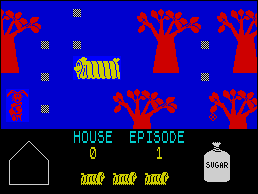
IN The Magic Roundabout, from CRL, Dougal and the gang are still playing happily in the Magic Garden where Dougal's aim is to build a house of sugar before bedtime. He has to collect lumps of sugar dotted around the garden and dump them at the Magic Mushroom - resembling a deformed flower - where a train will appear to transport them to his house.
Sprite characters make up the graphics and although they are a faithful copy of the original characters the movements are jerky and slow.
Not a game to start the adrenalin flowing - in fact it will continue to course sluggishly through your veins - it is great nevertheless to see that Dougal and friends are still around, even if they have been incarcerated in RAM for posterity.
Clare Edgeley
| MAGIC ROUNDABOUT | Memory: 48K | Price: £6.95 | Joystick: Protek, Kempston, AGF | Gilbert Factor: 5 |
BASED on the book by Terry Jones, Erik the Viking, although published by Mosaic, has been programmed by Level 9. The adventure does not simply rehash the original but uses extracts from it to provide background and clues for a new saga.
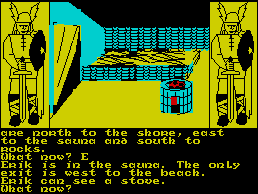
Erik has settled down to become a prosperous farmer. While his sons go a-viking in the summers he prefers to sit by his hall fire and hear their tales. His contentment is short-lived and one day, as he snoozes under a tree out on his pastures, his farm is raided by strange creatures from the outlands. He wakes to find his family and wealth have been taken.
The game begins at this point and Erik's task is to get his ship and crew together and then head down the fjord to the open sea. Appalling danger and powerful magic await him.
The program is attractively presented and the location graphics are well made, giving a fair flavour of the period. They take a little time to draw but can be removed by entering 'words'. The scenario is imaginative and full of event. There are enchanters, goddesses, sea monsters and vicious enemies.
The puzzles appear to be quite complex, as we might expect from Level 9, and Erik's journey is full of choice and decision. Even setting off requires a lot of forward planning.
The interpreter does not seem to have suffered too badly from the space given over to graphics though there were times when it could have been more helpful. In general, though, Erik the Viking is entertaining, complex and very good to look at. Even with a few minor criticisms Level 9 games are well above the normal standard of most adventures and this one is no exception, a blend of heroic adventure and detective story.
Richard Price
| ERIK THE VIKING | Memory: 48K | Price: £9.95 | Gilbert Factor: 8 |
EDDIE KIDD may have found it a doddle jumping 14 buses but in Jump Challenge it is not so easy.
In the official Eddie Kidd version from Martech Games, you are given the chance to beat Eddie's world record jump - secure in the knowledge that every time you fail your bones remain intact.
Pedalling furiously on your BMX, you warm up with a gentle jump over a mere 18 oil drums. It is quite easy - complacency sets in.
On graduating to motor bikes there is a relatively small jump over eight cars for starters! If, as the instructions state, you land with your back wheel on the ramp you should he all right.
The game calls for a large combination of skill, luck and the ability to judge speeds and distances. The speedometer and rev counter are a help but the main idea of the game is to teach the player to 'get the feel' of the bike.
The position of the rider is critical during the flight as he controls the angle of the bike. Making him lean backwards or forwards alters the bike's trajectory so that a safe landing can be negotiated. You will need to put in a lot of practice to get it right.
The game is well written and includes all the elements of skill and co-ordination that make an exciting program. There is one irritating aspect. If you repeatedly fail to clear the eight car stage, the game will end and start again with the BMX warm-up. When you are itching to get Eddie into the air, that stage seems a waste of time.
Clare Edgeley
| JUMP CHALLENGE | Memory: 48K | Price: £6.95 | Joystick: Not specified | Gilbert Factor: 6 |
ZENJI is a strange game but one which has become a cult in the United States. It is an Activision import which has been hurriedly translated to the Spectrum.
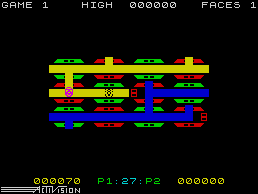
In order to become a master you must rely on your intuition to feel the forces flowing through the game's maze. Your playing piece is a face which revolves as you move the joystick or the keypad defined on the keyboard.
It starts at a central element and you must move it round the corridors and connect it to other elements which lie at the nodes of the corridors. If you hit a connection then a power wave is started between the original and new element and a link established. Part of the maze lights up with the radiance that those sources give off.
The higher levels of the game involves mazes which fill the whole screen and creatures which will only be too happy to feed on the energy that propels your character. If you bump into one then you will lose a life.
You will find that you will get better at the game and reach the higher levels but in Zenji experience is gained through insight and not mental reasoning. There is a way to beat the game at all its levels using logic but that spoils the excitement and we do not intend to reveal the answer.
Ultimately, Zenji is a test for two players. When you have enough mastery over the mazes then you should find a friend to pit your wits against.
John Gilbert
| ZENJI | Memory: 48K | Price: £7.99 | Joystick: Programmable, Sinclair, Kempston, Cursor | Gilbert Factor: 8 |
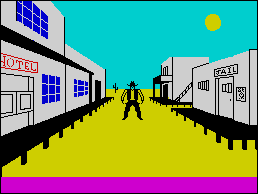
IN A RID to capitalise on the computer gaming scene, British Telecom has recently entered the market with their Silver range of games - priced at £2.50.
They are a mixed bag. BT's claim that the games are worthy of a five pound price tag seems to be applicable to only two of the games reviewed here. The remaining two would be expensive at any price over £2.50.
In Booty, you play the part of Jim the Cabin Boy who finds himself aboard the infamous pirate ship - the Black Galleon. One night while most of the pirates are sitting down to a steady drinking spree Jim creeps round the levels of the ship to steal their loot.
However, life is not always a game and Jim finds himself in the suds when he realises that not all the pirates are drunk - some have been left on guard. To get into their cabins, he has to steal the keys from under their noses.
The graphics are excellent with half the game portrayed in the increasingly popular style reminiscent of Sabre Wulf and Pyjamarama.
Viking Raiders is a different kettle of fish. It is a strategy game set amongst warfaring vikings back in the days of King Canute.
There are four armies, each headed by a Viking chief. The aim is to defeat the other three armies and become victor and ruler of the area. Dirty tricks abound and your catapults can be used to devastating effect.
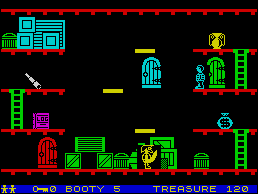
The graphics are sparse and basic. Each army takes a different colour which is hard on the eyes. Bright blues, pinks and greens may look nice in the programmer's imagination but they look terrible to the player who has to squint to see what is going on. However, there is enough appeal in the game to detract from these basic graphics.
The remaining two games are The Wild Bunch and Exodus. The Wild Bunch is an adventure set in the wild west. Framed for a murder you didn't commit, you are out to nail the Wild Bunch. The game resembles a superior multiple choice with a selection of options given to you at every move.
Adventures written in that style are rarely as exciting as those written in the more conventional mode - they rapidly become tedious. Billed as a graphical adventure, The Wild Bunch has a few scenes dotted around the adventure which are well depicted. For the most part though it appears to be mostly text.
Exodus is your average arcade game packed with characters cloned from other games. Mutant llamas abound, hovver mowers, galleons and TV sets lurk and assorted aliens merely fail to get you. The game lacks excitement, the graphics flicker and the sound is fairly average.
Clare Edgeley
| BOOTY | Memory: 48K | Price: £2.50 | Joystick: Kempston, Sinclair, Programmable | Gilbert Factor: 7 |
| VIKING RAIDERS | Memory: 48K | Price: £2.50 | Gilbert Factor: 6 | |
| THE WILD BUNCH | Memory: 48K | Price: £2.50 | Gilbert Factor: 5 | |
| EXODUS | Memory: 48K | Price: £2.50 | Joystick: Cursor, Kempston | Gilbert Factor: 3 |
ONCE they have fathomed how to choose the game control options budding BMX star-warriors should have a pretty good time with Starbike, a fast arcade production from The Edge.
You must steer your starbike across the planet's surface to rescue friendly droids and return them to the safety of your lander module via a teleport located in your sector.
Large numbers of hostile alien objects swarm over the screen and will eventually wear out your shields and send you to wherever it is deceased BMX star-warriors are supposed to spend eternity.
There are a number of control options and you can choose from several joysticks, the Fuller Master Unit, Interface 2 and Currah micro-speech. Working out how to select those requires a couple of A Levels.
It may take you some time to get used to the thrust controls but, all told, the game is exciting and quite addictive.
Richard Price
| STARBIKE | Memory: 48K | Price: £6.95 | Joystick: Kempston, Fuller, Protek, Sinclair | Gilbert Factor: 6 |
AS A RESULT of the tremendous success of Track & Field in the arcades in this, the Olympic year, a number of companies have jumped on the bandwagon to produce clones for all micros.
The latest to enter the great race is Melbourne House with Sports Hero.
Crammed into the Spectrum's memory are four events - 100 metre sprint, long jump, 110 metre hurdles and the pole vault with a choice of three levels.
Under starters orders - BANG - and the runners were off, haring through the streets past graffiti covered billboards proclaiming 'Brixton Rules'. No time to recover - on to the next event.
If you qualify in all four events you will go onto the next level where you will find yourself running for the university team.
The game is played in the same way as Track & Field where you have two run buttons and a jump button - necessary for hurdles, pole vault and the long jump. In order to run you will have to press the run buttons rapidly and an indicator will chart your speed.
A few small grouses - there isn't any sound except for a bleep from the starter's pistol. The game would be greatly enhanced if you could hear the sound of feet pounding up the track.
Sports Hero is a one player game so you do lose the competitive aspect when playing with someone else and there are only four events albeit over three difficulty levels. Programmers are stretching the Spectrum to its limits - more events would have added a welcome variation.
Clare Edgeley
| SPORTS HERO | Memory: 48K | Price: £6.75 | Joystick: Sinclair, Programmable | Gilbert Factor: 6 |
EUREKA, Ian Livingstone's package, from Domark, contains something for everyone. Each of the five sections is prefaced with an arcade game which builds up the character's strength, or vigour, but tires the playing fingers.
In the prehistoric maze you are represented by a little figure, the size of a character square and difficult to distinguish from its background. You must guide it around the maze, picking up roast chicken legs while avoiding flashing squares which rush at you and jumping on those which try to run away.
All those antics have a strange sort of logic to them. If you want to keep your sanity, however, it is best to pick up the nearest leg and make a dash for the exit. If you are not quick enough on the fire button, for this game surely requires a joystick, more chicken legs are scattered around the maze.
Once through the finger punishment phase one of the adventures may be loaded. Those take you into a series of time slips through which you have to travel to find the pieces of a talisman first discovered on the moon by Apollo XVII but later shattered and lost in time.
First stop is the prehistoric age in which you can become breakfast for a dinosaur, discover hidden pitfalls, and become lost in one of the many forests which dominate the land.
If, after that, you are inclined to travel further you can load the next program and slip back to Ancient Rome where the slaves are revolting and the lions ravenous. Livingstone's long association with role-playing games ensures that full mythology value is injected into the scenario.
The mythological strain continues with a trip to Celtic Britain where you have to rescue the wizard Merlin and meet the crew of Camelot.
Once you have got those pieces of the talisman you can travel to the two final segments of the package which take place in the near past.
Despite the combination of arcade and adventure games the package is disappointing as it offers nothing new.
The package is good value however, especially considering the £25,000 prize for the lucky winner.
John Gilbert
| EUREKA! | Memory: 48K | Price: £14.95 | Joystick: Kempston, Sinclair | Gilbert Factor: 8 |
THE USUAL lantern-jawed, muscle-bound hero adorns the cover of Tower of Despair from Games Workshop. A swift reading of the background history reveals a plot and setting not too far removed from Lord of the Rings - the hellish and very nasty sorcerer has resurfaced and orcs are abroad.
The Wizards' Council is extremely worried and has summoned you, the warrior-mage of Castle Argent and part-time weight lifter, to remove this Malnor chap and his demonic legions.
To do that you must find the Golden Gauntlet, currently in the possession of another elderly ex-hero. Journey through the wilderness, survive many perils, find the Tower, rub out Malnor. So much for the plot.
The adventure contains two complete sections. The program is written on the Quill and is text-only, though the character set has been changed to a pleasant medieval script with the occasional illuminated capital.
Naturally enough there are assorted monsters to overcome and care will need to be taken with the magical artefacts you encounter.
D & D devotees will probably feel at home in the land of Aelandor but more reluctant heroes may find they have been there too many times already.
Richard Price
| TOWER OF DESPAIR | Memory: 48K | Price: £7.95 | Gilbert Factor: 5 |
ALTHOUGH there have been many attempts to produce wargames on the Spectrum of comparable quality to the boardgames of the mid-seventies, few have managed to match their ancestors.
Lothlorien has attempted to rectify that with Confrontation, a system which allows players to define their own maps and forces for play.
The system suffers from being a two-player game, relegating the computer to the role of the umpire.
Battles are modern in style, with armoured and foot infantry, aircraft and artillery. The mechanics are of the move-fire type, with mobile units moving first and each player moving in turn.
The graphics are attractive and easy to follow. There are no confusing figures to interpret.
The Confrontation package includes a simple scenario to start you off. Lothlorien has also released a cassette of scenarios based on 'real' events, which cannot be used without the original program.
The scenarios are bold in conception; Egypt vs Israel across the Sinai desert is an exercise in chess-like precision of communication lines.
An Angolan scenario in which Unita defends coastal strongpoints against Cuban-trained forces introduces the possibility of South African reinforcements.
Operation Sea Lion enters the world of alternative history with the German invasion of Kent, while the fourth scenario has a Soviet column attempting to force a passage through the mountain passes of Afghanistan.
All of the scenarios, as well as the main program, are well-constructed and represent challenging problems for keen wargamers. They will welcome the series with enthusiasm. But those who cannot claim to be avid armchair generals are less likely to find a sometimes frustrating business enthralling enough to justify the investment.
Chris Bourne
| CONFRONTATION MASTER PROGRAM | Memory: 48K | Price: £7.95 | Gilbert Factor: 7 |
| CONFRONTATION SCENARIOS VOLUME 1 | Memory: 48K | Price: £5.95 | Gilbert Factor: 7 |
DUPLICITY, cunning and self-interest are the keynotes of the 1984 Cambridge Award winner, The Prince, written by John Sherry and published by CCS. The title is consciously derived from Machiavelli's handbook of politics and is designed for four players.
Set in a gloomy renaissance fortress the game is a combination of strategy and adventure formats. The aim is to become Loremaster and chief counsellor to the Prince, ruler of this land, and each character must get to the top by any means possible - whether it be theft, kidnap or mayhem.
After engaging the services of henchmen - who can 'hit' other castle servants and characters - and spies who can report on the actions of other people, each player moves around the fortress giving instructions to his staff and trying to secure the tokens which will ensure advancement. Goods can be bought and sold from the castle trader and a banker will arrange transfers of cash. Each player has a passcode which will allow him to take his turn - other players are not supposed to observe this but are sure to try.
Life is not simple since any of the spies and henches recruited may well be working for other player-characters and information may be bought and sold.
The computer keeps track of your money and possessions and informs you of your current position at the beginning of each turn. Input is in standard verb/noun combinations and there is a hidden vocabulary besides the predefined commands for controlling your gang.
The Prince will involve you in much bargaining and chicanery with the three other human players. Alliances may be formed and broken, lying and deceit will be the most normal interactions. An audience with the Prince himself is possible but he is temperamental and will brook no impertinence.
Ten inputs are allowed for each turn so you must plan your strategy carefully. Pictures of the people you are talking to are shown on-screen and the character set is a mock-gothic script.
The game is well-constructed and, since you only ever have a partial view of the goings on, is full of the unexpected. Diplomacy addicts will feel quite at home here as the web of treachery spreads through the palace and it is easy to become utterly absorbed in your character.
Richard Price
| THE PRINCE | Memory: 48K | Price: £7.95 | Gilbert Factor: 8 |
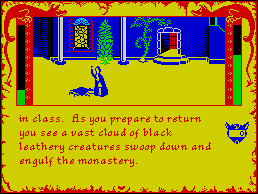
BEFORE your very eyes the bestial forces of the Darklords have destroyed your monastery and friends. Revenge is in your heart but you must first reach the capital and warn the king of the impending onslaught. War and danger will bedevil your every step.
Flight from the Dark is the computer version of the Arrow single role-play book and the program is packaged with it for double enjoyment and references. The program contains new situations but follows the original plot and the screen display will show if you are dealing with a section of the book by indicating the relevant paragraph.
Options are scrolled up below the graphic display and the choice is made by a keypress. Other actions are also controlled by single keys and an overlay is provided for the purpose - this could have been made more solidly.
The graphics are animated and you are shown walking or riding through the locations. If you encounter an enemy there is a very clever combat sequence which allows you to thrust, swipe, chop and parry with whatever weapons you currently hold. This is in real time and can be a nail biting experience as your survival will depend on the fighting skill you have built up in the course of your travels.
Addicts of the book version will find the program every bit as demanding and exciting. The general quality of the graphics enhances that pleasure.
Richard Price
| FLIGHT FROM THE DARK | Memory: 48K | Price: £8.95 | Gilbert Factor: 8 |
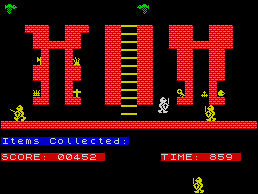
IF YOU OWN a 16K Spectrum and have felt left out since Manic Miner and Jet Set Willy were produced for the 48K machine then Sir Lancelot, from Melbourne House, may take away some of the heartache.
Although the author does not equate the game with the best-selling Willy series there are some obvious parallels. As the fabled knight in shining armour you must investigate 24 rooms through which have been strewn treasures, including keys, crowns and gold, and seven different types of monster. They move mechanically up and down or across the screen and your task is to develop a strategy to defeat them and retrieve the treasure.
The solutions to the treasure quests on each screen are made harder when the objects seem to be out of reach. However, each screen contains an answer and it just takes practice to get to the next one.
Sir Lancelot is a 48K game crammed into a 16K machine and as such the author should be congratulated.
John Gilbert
| SIR LANCELOT | Memory: 16/48K | Price: £5.95 | Joystick: Kempston, Sinclair, Cursor | Gilbert Factor: 7 |
OTHER programmers will find it difficult competing with Tir Na Nog from Gargoyle. Until you have loaded up you may think that the booklet's boast of a 'computer movie' is pushing it a bit. Not so - this animated graphics adventure is bound to become a classic of Spectrum programming and portrays the travels and adventures of the hero Cuchulainn through the Celtic afterworld, Tir Na Nog.
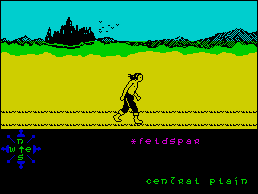
Cuchulainn strides tall, clear and purposeful along the paths of his world. Fore-, middle- and backgrounds scroll independently behind him, giving a convincing likeness of real movement. The camera angle can be altered so that he can be seen from four viewpoints and the scenery changes accordingly. The clouds roll, smoke billows, birds flutter.
Other characters are shown in equal detail and live their own lives whilst Cuchulainn obeys you in his search for the fragments of the Seal of Calum.
Not that you have to pursue the quest. You may choose to wander the roads and explore the intricacies of the world or follow secondary objectives that may well need to be completed before the major aim can be accomplished. Other characters may lay tasks on you too and events may force you in a certain direction at times.
Beware of the Sidhe, those powerful, dangerous and magical beings who also use the pathways. Combat may occur if all else fails and Cuchulainn can thrust with any weapon he may have found. To progress and survive you will need persistence, lateral thinking and good luck though of course you cannot be killed, merely returned to the beginning.
The game is not designed as a text adventure and uses the keyboard for movement and initiating various actions. Do not be misled by this into thinking that it is an arcade game - the program scope is vast and the world it depicts is alive and full of atmosphere. This is a full adventure and, with no single or simple solution, may keep you occupied for a long, long time. Highly original and stunningly presented.
Richard Price
| TIR NA NOG | Memory: 48K | Price: £9.95 | Gilbert Factor: 9 |
BECOME a master of the ancient oriental art of Kung-Fu without dislocating your back or having the wind knocked out of you.
Kung-Fu, from Bug-Byte, is described as a totally animated combat game for two players or one player and the computer.
Each player controls one of the Kung-Fu fighters which must approach each other in a very inscrutable way before bashing the hell out of each other. Bug-Byte may enthuse about the graphics and crow about the cleverly designed fighters but, although the display initially looks impressive, movement is jerky, and action slow. The fighters move as if they are robots.
Much emphasis is put on the techniques which the fighters can use when in action. Such moves are fairly authentic but the movement between a standing pose and making contact with the other player could have been made more realistic.
If you are going to play Kung-Fu with any kind of agility then you will need a joystick. You will then at least get some enjoyment out of it and not get whitewashed by a computer Ninja.
John Gilbert
| KUNG-FU | Memory: 48K | Price: £6.95 | Joystick: Programmable, Cursor, Sinclair, Kempston | Gilbert Factor: 6 |
CLAIRVOYANTS should have a ball with Turtle Timewarp from Softstone. A brief examination of the cassette blurb reveals nothing about the game apart from the loading instructions.
After a nice loading screen information appears offering redefinable keys, joystick and start options. Fine, you say, and punch the start key, thinking that enlightenment will arrive before the game gets under way.
It does not. The only reference to the aim of the game is the brief 'save all turtles in this amazing game' on the back end of the insert.
The screen depicts a small 2D maze with question marks in the dead-end portions. You manoeuvre a turtle round the maze into the question marks. Sometimes that results in the creation of unpleasant insects to add to those already chasing the turtle.
Sometimes a house is materialised which blocks off corners and makes life more difficult for the biting bees. If they get you, you lose a life. Once you have managed to explore all the question marks you move up a screen.
With no game concept to latch onto the business seems singularly pointless, though the graphics are reasonably fast. The competent rendering of Für Elise was more gripping than the game and the choice of question marks as symbol very apt. A crystal ball could come in handy if you have one.
Richard Price
| TURTLE TIMEWARP | Memory: 48K | Price: £2.99 | Joystick: Kempston | Gilbert Factor: 4 |
DOWN to earth at last, Kim Kimberley, secret agent extraordinaire and saviour of the starship Snowball, has been framed for an act of sabotage. Fleeing the wrath of the woken colonists she steals a stratoglider and enters the atmosphere of Eden, the Snowball's destination. Condemned to death she has only a short time to hide in the luxuriant and bizarre undergrowth of the planet. The ship need only turn its engines towards her to fry her to a crisp.
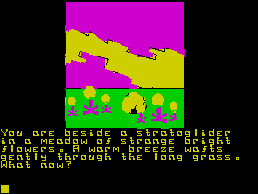
So begins Return to Eden, another brain scrambling adventure from Level 9 and sequel to Snowball. The presentation has changed - the game includes location graphics, yellow word display on a black background and 'write ahead'. That feature allows you to input text in a continuous flow without waiting for the cursor to reappear.
There are around 250 locations and Level 9 claims that the use of graphics has not adversely affected the amount of description or the general quality. Initial exploration seems to back that up. If you find the graphics too slow they can be switched out.
Once safe in the jungle you must head out for the robot-manned city in the east. You must survive amongst the beautiful but lethal flora and fauna and avoid the robot devices which protect the city.
Problems and puzzles abound; this is a world unknown to humans and many plants or creatures have odd properties. Just trying to survive ten minutes is difficult - Level 9 keep rolling those heavy dice on you but give you a few resurrections before finishing you off.
Exhausted compulsives of the firm's other works may just as well admit to themselves now that they probably won't be sleeping much for the next few months. Atmospheric and original.
Richard Price
| RETURN TO EDEN | Memory: 48K | Price: £9.95 | Gilbert Factor: 8 |
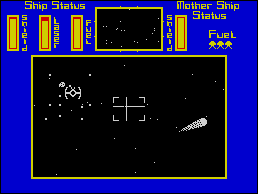
THE AGE OLD game of Star Trek has been resurrected to bring to your screens New Cylon Attack, from A'n'F Software.
Following the successful BBC version of the game, New Cylon Attack now boasts improved graphics and playability.
The storyline is familiar and brings to mind scenes of a portly Captain Kirk at the helm of the Starship Enterprise. You are pilot on board a supply ship carrying reinforcements to a distant planet in a war-torn galaxy.
The game portrays the sights of your laser gun in the middle of the screen with moving crosshairs. By moving these you are able to pinpoint the Cylons as they fly at the mothership.
As well as the radar scanner there are a few other instruments which need constant monitoring including fuel situation, the state of your lasers and shield strength.
Your tanks may be refuelled during the game, which involves wandering round space looking for the mothership to dock on to. No fun with empty tanks and as often as not your fuel will run out just as she is in sight.
The graphics aren't astounding and the sound fairly average. New Cylon Attack is not the most original game but it is by no means the worst.
Clare Edgeley
| NEW CYLON ATTACK | Memory: 48K | Price: £5.75 | Joystick: Kempston | Gilbert Factor: 5 |
BETA BASIC, from Betasoft, has already established itself as the standard extended Basic for the Spectrum. The launch of version 1.8 confirms that view with routines added to support Interface and microdrives.
The new language adds 30 new commands and 20 functions to Sinclair Basic and makes use of the structuring commands which are available for machines such as the BBC Micro and the Commodore SX-64.
The language is so much better than the Sinclair Basic. As well as the structure commands such as DEF PROC which creates procedures similar to those on the QL there are also programming aid utilities, graphics commands, easier access to the memory of the Spectrum and a real time clock which even has an alarm.
The utilities include an AUTOline number command, a command which TRACEs the number of a line as it is executed in a program RUN and a horizontal screen SCROLL which behaves in a similar fashion to that on the ZX-81. There is also a ROLL utility which will scroll the screen vertically in any direction.
The 20 new functions include a PEEK which looks at 16-bit words, decimal to binary, and decimal to hexadecimal converters, a SCREEN$ command which recognises both ordinary and user defined graphics and a function to convert a number into a different format such as that of decimal currency.
It is a great pity that Sinclair Research has not brought out a version of Beta Basic on its new Spectrum+ either on board the machine or as a microdrive cartridge or ROM. Betasoft turns Sinclair Basic from a good version of the language to a fantastic one.
John Gilbert
| BETA BASIC | Memory: 48K | Price: £11.00 | Gilbert Factor: 9 |
A "REVOLUTIONARY" concept, at least according to publisher Computer Records, has recently hit the streets in the form of a compilation of 12 popular games from companies including Bug-Byte, Quicksilva, Anirog and Ocean.
They have been released under the collective title Select 1 and the company claims that if every game was brought separately the player would have to pay about £70.00. Quite a saving.
Some of the games are ancient but in the same package you will find more recent titles which include Hunchback, Mr Wimpy, Missile Defence, Pool, Denis through the Drinking Glass and Moon Buggy.In Denis through the Drinking Glass, the idea is to help Denis Thatcher stagger to the Gravediggers Arms to revitalise the parts that Maggie cannot reach.
In this Quilled adventure from Application Software, Denis is at his wits end - there is not a drop of booze at No 10. Escaping from Maggie's loving clutches is no easy matter and apart from the worry of being caught by the wife he has to negotiate sundry personalities as Mary Whitehouse and Ken Livingstone en route.
The player has only ten moves in which to find the elusive flask of gin which makes up Denis' breakfast. Without it he will fall into a stupor and the game will end. Delirium tremens sets in if at the ninth move Denis still hasn't had a swig.
Denis through the Drinking Glass gently mocks the Iron Lady and her retinue in a game which can be great fun.
Missile Defence from Anirog is based on the classic arcade game where you have to protect your city from a murderous alien attack. The game is quite fast, but your bomb sights move too slowly to contain the aliens on the higher levels.
Moon Buggy, also from Anirog, is a poor representation of the original game. The graphics are sketchy with an almost unchanging background, and the aliens are almost non-existent.
However, the package is very good value especially as a Christmas present. You may well have most of the games but even the three or four games which are new to you will make the package worthwhile.
Clare Edgeley
| SELECT 1 | Memory: 48K | Price: £12.49 | Joystick: Available for some of the games | Gilbert Factor: 7 |
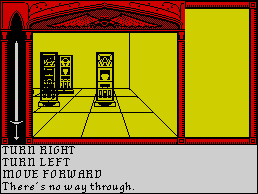
REMEMBER the old dinosaur mazes? Moving along one square at a time you could turn right or left to enter side passages. King Arthur's Quest uses a similar type of movement system, though the countryside and rooms depicted are not bounded in the same way.
The wicked Morgana Le Fay has put a spell upon the land. The world is slowly dying and you must save it from the Enchantress and her magic. You begin in Merlin's cottage and must examine the grids to collect useful objects or meet the various characters.
There are nine basic actions each carried out by a single key press - a rather flimsy overlay is provided to show the relevant keys.
This is not a normal text adventure, given the very limited range of input, and may consequently appeal to a younger age group. The graphic displays are sufficiently pleasant, though unoriginal in style, and the response time is fast. There is a microdrive transfer facility but if you are killed during play you must reload.
Richard Price
| KING ARTHUR'S QUEST | Memory: 48K | Price: £7.95 | Gilbert Factor: 4 |

FOURTH down and three. Will you run or pass?
If that means little to you then you are clearly no fan of American Football. Recent television coverage of the sport has aroused an interest in Britain, and Argus Software has responded by releasing a simulation, American Football.
The game is a strategy version, in which you as the team coach select your style of attack or defence from a menu, and the computer, or another player, selects a response. The results are displayed on the screen with animated graphics rather in the style of Football Manager, with small figures moving into various positions and working through the selected plays.
American Football lends itself well to computer simulation, as the real game is played as a series of tactical set pieces where the object is to gain as many yards from a single play as possible, before scoring a touchdown by taking the ball across the opponents' goal line. Since the game proceeds in fits and starts, the computer version does not lose so much realism as comparable versions of Soccer or Basketball.
Those who are not familiar with the sport are nevertheless unlikely to be enthusiastic about the game, as it only really becomes fun if you allow your imagination to visualise what is being simulated.
For those who do know something of the game, the program is much more fun, and can be heartily recommended.
Chris Bourne
| AMERICAN FOOTBALL | Memory: 48K | Price: £9.99 | Gilbert Factor: 7 |